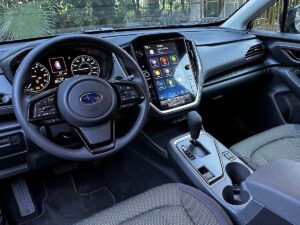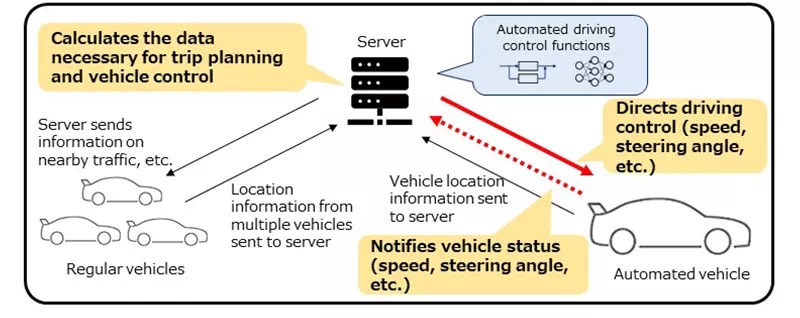In the relentless pursuit of innovation, Subaru Corporation has made a bold move by installing a local sub-6 5G standalone (SA) network at their Bifuka Proving Ground in Hokkaido, Japan. This state-of-the-art network is designed to support Subaru’s cutting-edge research into cooperative driving automation, a technology that allows vehicles to communicate with each other and with infrastructure to enhance safety, efficiency, and overall driving experience. While this advancement is a testament to Subaru’s commitment to staying ahead in the competitive automotive industry, it also raises critical concerns about the potential health risks associated with increased exposure to electromagnetic radiation (EMR) from 5G technology.
In this article, we will delve deep into the implications of Subaru’s 5G network from both a technological and a health perspective. We’ll explore the benefits that 5G brings to the automotive industry, examine the scientific evidence surrounding the health risks of EMR, and discuss how companies like Subaru can mitigate these risks through the implementation of proven EMF protection strategies, such as those offered by Aires Tech.
The Technological Leap: Subaru’s 5G-Enabled Future
Subaru’s decision to integrate 5G technology into their Bifuka Proving Ground is a forward-thinking move that positions the company at the forefront of automotive innovation. The sub-6 5G SA network installed at the proving ground enables real-time communication between vehicles and infrastructure, which is crucial for testing and developing cooperative driving automation systems. These systems rely on high-speed, low-latency connectivity to coordinate complex driving maneuvers, such as merging, lane changes, and collision avoidance, with precision and reliability.
The benefits of 5G in this context are clear. By leveraging the high bandwidth and low latency of 5G, Subaru can gather and process vast amounts of data in real-time, allowing for more accurate simulations, better decision-making algorithms, and ultimately, safer and more efficient vehicles. This technological leap is not just about keeping up with the competition; it’s about setting a new standard in automotive safety and performance.
A Brief Overview of Mobile Network Evolution
To fully understand the significance of 5G, it’s important to briefly look back at the evolution of mobile networks. The journey from the first generation (1G) to the current 5G technology has been marked by significant advancements in speed, capacity, and connectivity. Each generation of mobile networks has brought new capabilities and conveniences, but also new challenges and health concerns.
1G: The first generation of mobile networks, introduced in the 1980s, allowed for basic voice communication using analog technology. While revolutionary at the time, 1G networks were limited in capacity and coverage.
2G: The second generation, launched in the 1990s, marked the transition from analog to digital technology. This shift enabled more reliable voice communication and introduced services like text messaging (SMS).
3G: The third generation, which came into widespread use in the early 2000s, brought mobile data to the forefront, enabling internet access and multimedia messaging on mobile devices.
4G: The fourth generation, rolled out in the 2010s, revolutionized mobile communications by delivering high-speed internet, enabling seamless streaming of video and audio content, and supporting a wide range of applications and services.
5G: The fifth generation represents a quantum leap in mobile technology. With its ability to transmit data at unprecedented speeds and connect a massive number of devices simultaneously, 5G is poised to transform industries, from healthcare and manufacturing to transportation and beyond.
While each generation of mobile networks has improved our ability to communicate and share information, it has also increased our exposure to EMR. The introduction of 5G, with its higher frequency bands and denser infrastructure, has amplified concerns about the potential health risks associated with prolonged exposure to EMR.
The Health Implications of 5G: Unveiling the Risks
As 5G technology becomes more prevalent, so too do concerns about its impact on human health. The higher frequencies used by 5G, particularly in the millimeter wave (MMW) spectrum, have raised questions about the biological effects of long-term exposure to EMR. A growing body of research suggests that EMR, especially at the frequencies used by 5G, can have a range of adverse health effects, from oxidative stress and DNA damage to neurological and reproductive issues.
Oxidative Stress and DNA Damage
One of the most well-documented effects of EMR exposure is the promotion of oxidative stress, a condition characterized by an imbalance between free radicals and antioxidants in the body. Oxidative stress can lead to cellular damage, inflammation, and a host of chronic diseases, including cancer. A study by the International Journal of Hygeine and Environmental Health highlights the link between RF-EMF exposure and oxidative stress. The study found that RF-EMF exposure increases the production of reactive oxygen species (ROS), leading to oxidative stress and subsequent DNA damage, which is a critical factor in the development of various health conditions, including neurodegenerative diseases and metabolic disorders.
This is particularly concerning for environments like Subaru’s test course, where the density of 5G infrastructure means that employees are likely to be exposed to higher levels of EMR than the general population. Prolonged exposure in such settings could potentially lead to an increased risk of chronic health issues, making it essential for Subaru to consider strategies for mitigating these risks.
Carcinogenic Potential
The International Agency for Research on Cancer (IARC), part of the World Health Organization (WHO), has classified RF-EMF as “possibly carcinogenic to humans” (Group 2B), based on evidence linking RF-EMF exposure to an increased risk of glioma, a type of brain cancer, among long-term users of mobile phones. Given that 5G operates at higher frequencies and involves a denser network of base stations, there is concern that the carcinogenic potential of RF-EMF may be heightened with the widespread adoption of 5G.
Di Ciaula’s study supports this concern, suggesting that the biological effects of RF-EMF, particularly in the context of 5G, warrant further investigation. The study calls for the application of the precautionary principle, advocating for stricter exposure limits and more comprehensive research to fully understand the long-term health implications of 5G.
Neurological and Reproductive Risks
In addition to its potential carcinogenic effects, RF-EMF exposure has been linked to various neurological and reproductive health issues. Research has shown that RF-EMF can affect the nervous system, leading to symptoms such as headaches, dizziness, and cognitive dysfunction. These neurological effects are particularly troubling given the critical role that the nervous system plays in overall health and well-being.
Furthermore, there is evidence to suggest that RF-EMF can impair reproductive health, particularly in men. Studies have shown that exposure to RF-EMF can reduce sperm quality and fertility, potentially leading to reproductive challenges. Additionally, there are concerns about the potential impact of RF-EMF exposure on fetal development, particularly in environments with high levels of EMR, such as Subaru’s 5G-enabled test course.
Aires Tech: Mitigating EMR Risks at Subaru’s Facility

Given the potential health risks associated with 5G technology, it is imperative that Subaru takes proactive measures to protect its employees from the harmful effects of EMR. One of the most effective strategies for mitigating these risks is the implementation of scientifically proven EMF protection technologies, such as those offered by Aires Tech.
Aires Tech has developed a range of products designed to protect individuals from the harmful effects of EMR. These products use patented microprocessor technology to neutralize electromagnetic waves, reducing their biological impact on the body. By integrating Aires Tech devices into their facility, Subaru can significantly reduce the EMR exposure experienced by employees, ensuring a safer working environment.
How Aires Tech Devices Work

Aires Tech’s EMF protection devices are based on advanced resonator chip technology that restructures and harmonizes electromagnetic waves before they reach the human body. This process involves the conversion of harmful EMR into less biologically active forms, thereby reducing the potential for oxidative stress, DNA damage, and other health issues associated with EMR exposure.
These devices have been rigorously tested and validated by peer-reviewed studies, demonstrating their effectiveness in reducing the impact of EMR on human health. Aires Tech’s products are particularly beneficial in high-EMR environments like Subaru’s test course, where the potential for adverse health effects is heightened due to the dense 5G infrastructure.
Practical Implementation at Subaru’s Facility
Subaru can implement Aires Tech’s EMF protection devices in various ways to ensure comprehensive coverage across their Bifuka Proving Ground. Here are some practical strategies for integrating these devices into Subaru’s facility:
Vehicle Integration: Aires Tech devices can be installed directly in the vehicles being tested on the proving ground. This ensures that both the vehicles and their occupants are protected from EMR exposure during testing. This is particularly important for autonomous vehicles that rely heavily on 5G connectivity for real-time data processing and communication.
Testing Equipment and Control Rooms: Aires Tech products can be placed on key testing equipment and in control rooms where engineers and technicians spend significant amounts of time. These areas are likely to experience high levels of EMR due to the concentration of 5G signals, making them critical points for EMF protection.
Personal Protective Devices: Subaru can provide portable Aires Tech devices to employees for personal use. These devices offer continuous protection whether employees are on-site or off-site, ensuring that they are shielded from EMR exposure throughout the day.
Infrastructure-Wide Protection: Aires Tech’s larger-scale devices can be integrated into the facility’s overall infrastructure to create a protective shield that minimizes EMR exposure across the entire proving ground. This approach provides a holistic solution that addresses both individual and collective exposure to EMR.
By adopting these strategies, Subaru can demonstrate a commitment to safeguarding the health and well-being of its workforce while continuing to innovate in the automotive industry. This not only protects employees but also aligns with Subaru’s broader corporate responsibility to lead by example in health and safety practices.
The Need for Better Protective Measures
The rapid deployment of 5G networks worldwide has made it evident that we need to prioritize protective measures over further research. The detrimental effects of electromagnetic radiation are well-documented, and the science behind them is solid. Non-thermal effects, such as oxidative stress, DNA damage, and neurological impacts, have already been established. The time for debate has passed; now is the time for action.
Regulatory bodies and corporations must move beyond studying the problem and start implementing solutions. Current exposure limits, often based on outdated standards, do not adequately protect against the non-thermal effects of EMR. Companies like Subaru should lead by example, adopting stricter protective measures to shield their employees and the environment from the harmful effects of 5G radiation.
Corporate Responsibility: Subaru’s Role in Implementing EMF Protection

As a leader in the automotive industry, Subaru has a responsibility to ensure the safety and well-being of its employees. The evidence against prolonged EMR exposure is undeniable, and it is imperative that Subaru takes proactive steps to protect those working in high-EMR environments like their 5G-enabled test course.
Investing in EMF protection is not just a precaution—it’s a necessity. By implementing proven solutions, such as those offered by Aires Tech, Subaru can significantly reduce the risks associated with EMR exposure. This approach demonstrates a commitment to corporate responsibility and sets a standard for others to follow in prioritizing health and safety over unchecked technological advancement.
The Competitive Edge of Health-Conscious Innovation
Subaru’s proactive approach to EMF protection can also serve as a powerful differentiator in the marketplace. In an era where consumers are increasingly aware of the health implications of technology, companies that prioritize safety and well-being are likely to gain a competitive edge. By taking meaningful steps to address EMR risks, Subaru can enhance its brand reputation, attract health-conscious customers, and lead the charge in responsible innovation.
The need for action is clear. The science supports it, and the risks are too significant to ignore. Subaru has the opportunity to be at the forefront of a movement that not only advances technology but also safeguards health. This is the future of responsible innovation—where progress and protection go hand in hand.
Conclusion: Striking a Balance Between Innovation and Health
Subaru’s installation of a 5G network at the Bifuka Proving Ground represents a significant step forward in automotive innovation. The technology promises to revolutionize how vehicles communicate and operate, paving the way for safer and more efficient driving. However, as we embrace the benefits of 5G, it is crucial to remain vigilant about the potential health risks associated with increased EMR exposure.
By investing in proven EMF protection solutions like those offered by Aires Tech, Subaru can ensure that their pursuit of technological advancement does not compromise the health and well-being of their employees. This balanced approach allows Subaru to continue leading the way in automotive innovation while also setting a standard for corporate responsibility in health and safety.
In the end, the successful integration of 5G technology will depend not only on its ability to enhance automotive performance but also on how well companies like Subaru can protect their most valuable asset—their people. As 5G becomes more prevalent, it is imperative that we prioritize health and safety alongside innovation, ensuring that the future of technology is as safe as it is exciting.














